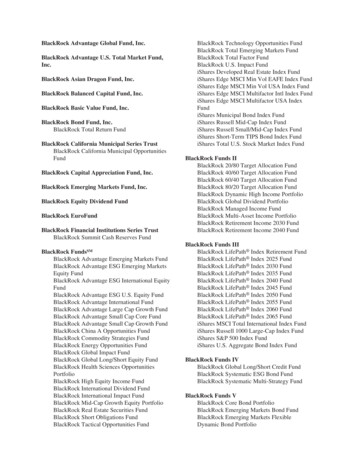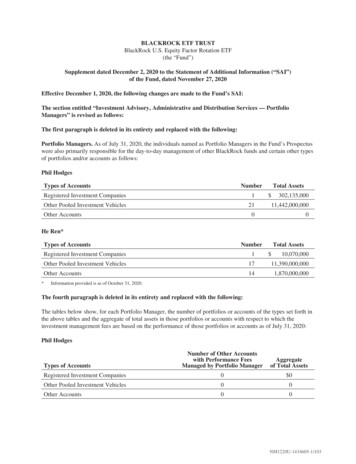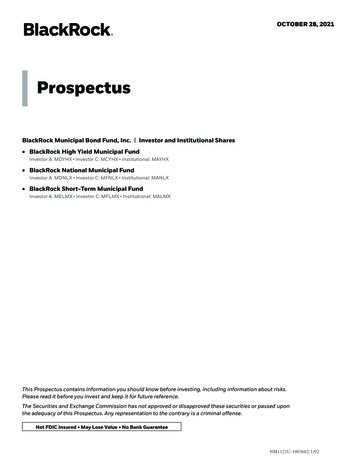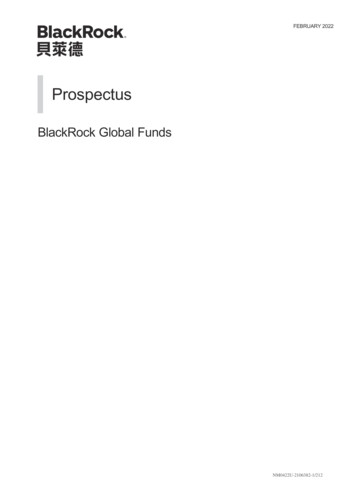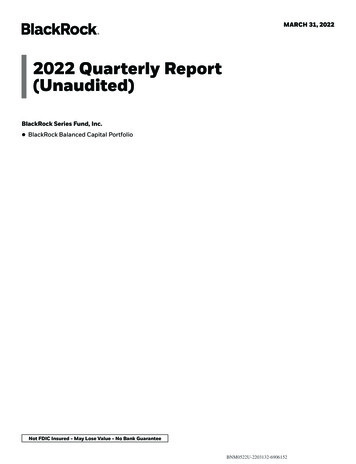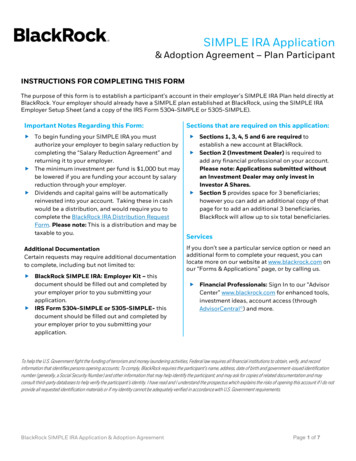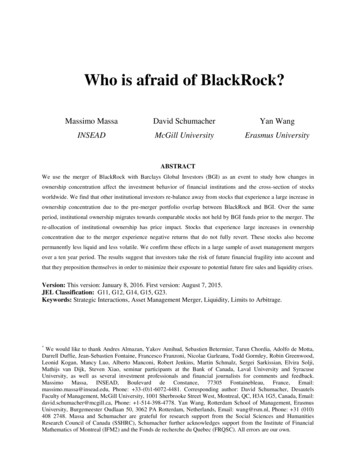
Transcription
Who is afraid of BlackRock?Massimo MassaDavid SchumacherYan WangINSEADMcGill UniversityErasmus UniversityABSTRACTWe use the merger of BlackRock with Barclays Global Investors (BGI) as an event to study how changes inownership concentration affect the investment behavior of financial institutions and the cross-section of stocksworldwide. We find that other institutional investors re-balance away from stocks that experience a large increase inownership concentration due to the pre-merger portfolio overlap between BlackRock and BGI. Over the sameperiod, institutional ownership migrates towards comparable stocks not held by BGI funds prior to the merger. There-allocation of institutional ownership has price impact. Stocks that experience large increases in ownershipconcentration due to the merger experience negative returns that do not fully revert. These stocks also becomepermanently less liquid and less volatile. We confirm these effects in a large sample of asset management mergersover a ten year period. The results suggest that investors take the risk of future financial fragility into account andthat they preposition themselves in order to minimize their exposure to potential future fire sales and liquidity crises.Version: This version: January 8, 2016. First version: August 7, 2015.JEL Classification: G11, G12, G14, G15, G23.Keywords: Strategic Interactions, Asset Management Merger, Liquidity, Limits to Arbitrage.*We would like to thank Andres Almazan, Yakov Amihud, Sebastien Betermier, Tarun Chordia, Adolfo de Motta,Darrell Duffie, Jean-Sebastien Fontaine, Francesco Franzoni, Nicolae Garleanu, Todd Gormley, Robin Greenwood,Leonid Kogan, Mancy Luo, Alberto Manconi, Robert Jenkins, Martin Schmalz, Sergei Sarkissian, Elvira Solji,Mathijs van Dijk, Steven Xiao, seminar participants at the Bank of Canada, Laval University and SyracuseUniversity, as well as several investment professionals and financial journalists for comments and feedback.Massimo Massa, INSEAD, Boulevard de Constance, 77305 Fontainebleau, France, Email:massimo.massa@insead.edu, Phone: 33-(0)1-6072-4481. Corresponding author: David Schumacher, DesautelsFaculty of Management, McGill University, 1001 Sherbrooke Street West, Montreal, QC, H3A 1G5, Canada, Email:david.schumacher@mcgill.ca, Phone: 1-514-398-4778. Yan Wang, Rotterdam School of Management, ErasmusUniversity, Burgemeester Oudlaan 50, 3062 PA Rotterdam, Netherlands, Email: wang@rsm.nl, Phone: 31 (010)408 2748. Massa and Schumacher are grateful for research support from the Social Sciences and HumanitiesResearch Council of Canada (SSHRC), Schumacher further acknowledges support from the Institute of FinancialMathematics of Montreal (IFM2) and the Fonds de recherche du Quebec (FRQSC). All errors are our own.
“In 25 years, BlackRock has become the world’s biggest investor. Is itsdominance a problem?” The Economist, December 7, 2013.“As a fiduciary asset manager, we have a duty to act in our clients' bestinterests. This includes protecting and enhancing the value of our clients’assets—that is, the companies in which we invest on their behalf—bypromoting good corporate governance.” BlackRock Website.1Despite the ominous title, the cover story of the December 7, 2013 issue of The Economist took quite aconciliatory tone arguing that “If the regulators’ concern is to avoid a repeat of the last crisis, they arebarking up the wrong tree. Unlike banks, whose loans and deposits go on their balance-sheets as assetsand liabilities, BlackRock is a mere manager of other people’s money. [ ] Whereas banks tumble if theirassets lose even a fraction of their value, BlackRock can pass on any shortfalls to its clients, andwithstand far greater shocks. In fact, by being on hand to pick up assets cheaply from distressed sellers,an unleveraged asset manager arguably stabilizes markets rather than disrupting them.”This logic is in line with the standard folk-theorem in finance. Since BlackRock does not invest onits own account, but just indirectly on behalf of customers, there is little reason to associate BlackRockwith systemic risk. To the contrary, a large presence of BlackRock among the stockholders of a firm maybe beneficial. Indeed, BlackRock can use its clout to improve the quality of governance of the companiesit holds in its portfolios.In this paper, we challenge the Economist’s logic and argue that the emergence of BlackRockimpacts all other investors who need to strategically account for the “big elephant in the pond” that couldpotentially “rock the boat” in the future. These investors could be afraid of potential future shocks toBlackRock that could trigger massive sales. We argue that this effect more than offsets the potentialpositive one associated with the governance role that BlackRock can play.Unlike prior research that has linked the level of existing ownership concentration to prices andvolatility (e.g., Greenwood and Thesmar (2011)), we do not focus on how idiosyncratic shocks toBlackRock directly affect prices and volatility once these shocks occur, but on how other investorsstrategically take concentrated ownership into account ex-ante. Strategic considerations, either driven byconcerns about future idiosyncratic events at BlackRock or by appreciation of improved governance, canlead to changes in portfolio allocations that may impact stock markets even in the absence of actualshocks.1Accessed on August 17, ible-1
For example, if BlackRock accumulates a large stake in IBM, other investors may decide tostrategically change their exposure to IBM as well. If they fear that potential idiosyncratic shocks toBlackRock could force a large and sudden sale of IBM stock (“fire sale”) and if they weigh thispossibility more than the positive governance implications of a large BlackRock presence in IBM, theywill re-balance away from IBM. Therefore, the mere “fear” of an idiosyncratic shock to BlackRock canmotivate investors to re-balance, thereby affecting the stock price of IBM already today.While idiosyncratic shocks causing such large redemption requests do not occur frequently, theindustry has seen a number of such episodes. For example, Kisin (2011) estimates that the 2003 “LateTrading Scandal” triggered average outflows of 14% (24%) of assets under management over thefollowing year (2 years) for the implicated mutual fund families, and Anton and Polk (2014) show thatthis event had a significant impact on the stocks commonly held by implicated funds. In addition, theindustry has seen a number of firm-specific scandals triggered by e.g., rogue-traders and internalgovernance failures (e.g., the 2008 incident at Société Générale or the 2012 “London Whale”), massivesales due to malfunctioning computer algorithms (e.g., the 2012 episode triggered by an algorithm of thefirm Knight Capital) or large-scale redemptions due to the departure of a star manager (e.g., the departureof Bill Gross from PIMCO) to name just a few examples. Any such shock to BlackRock could lead tolarge redemption requests across products if investors lose confidence in the firm and the literature onspillover effects in mutual fund families (e.g., Nanda, Wang and Zhang (2004), Sialm and Tham (2015))suggests that such spillovers could be significant. As such, we speculate that institutional investors taketheir possibility into account and condition their behavior ex-ante.However, identifying this ex-ante effect is empirically challenging because it involves theidentification of strategic interactions among investors – a topic plagued by endogeneity problems(Manski’s (1993) “reflection problem” 2 ). In this paper, we overcome these issues by exploiting anexogenous shock to the concentration of ownership in the cross-section of stocks worldwide. In 2009,BlackRock acquired Barclays Global Investors (BGI) to become the world’s largest asset manager. Thissingle merger fulfills all the criteria of a natural experiment to study how changes in ownershipconcentration affect the behavior of other investors and the stock market. First, the merger isunprecedented in scale. The combined entity oversaw about 2.7 trillion in assets under management atthat time. This makes the event impactful. Second, the event affected a large number of global stocks tovarying degrees, providing a necessary source of cross-sectional variation. We estimate that stocksrepresenting over 60% of world market capitalization were directly affected because they were held inboth BlackRock and BGI-managed portfolios prior to the merger. Third, the acquisition was exogenous to2The “reflection problem” captures the difficulty of identifying causality in peer behavior. For example, thebehavior of an individual could be caused by the behavior of some peer group, or the reverse, or none at all if allbehavior is caused by external, unobservable factors.2
the characteristics of the stocks held in the portfolios of BlackRock and BGI funds. Barclays sold BGI inorder to raise funds to strengthen its balance sheet in the wake of the 2008 global financial crisis to avoida possible future bailout by the UK government. BlackRock acquired BGI in order to establish a footholdin the fast-growing market of passive investment products (ETFs). This allows us to give a causalinterpretation to the merger-induced changes in ownership concentration and to the associated peer andstock market effects.We lay out two competing hypotheses. The first hypothesis, which we label the “fire sale riskhypothesis”, is based on the strategic interactions among investors in financial markets that take intoaccount the possibility of future fire sales and the strategic complementarities associated with them. Suchcomplementarities arise when the actions of market players reinforce each other.3 For example, they are atthe core of models on bank runs (e.g., Diamond and Dybvig (1983)) where the decision of one depositorto withdraw funds induces other depositors to withdraw funds first for fear of depleting bank reserves,leading to a bank run. The same intuition extends to asset management if a concentrated investorexperiences an idiosyncratic shock (e.g., large redemption requests) that induces a fire sale. Such asituation can lead to strategic complementarities if other investors try to pre-empt the sale by selling firstor if the price impact of the initial sale forces other investors to follow suit. Therefore, a change inownership concentration will induce other investors to re-balance away from the affected stocks in orderto hedge the risk of future fire sales.This motive is especially true when the other investors face constraints (e.g., margin constraints,short investment horizons, volatile flows, open-end structures, etc., Shleifer and Vishny (1997)) 4 thatimpede their ability to buffer liquidity shocks or when they hold the affected stocks primarily for liquidityreasons (i.e., when these other investors are “liquidity” or “noise traders”). In these cases, they areespecially vulnerable to potential future fire sales. It is less true for investors who hold the affected stocksfor information reasons (“informed investors”) as rebalancing would mean giving up information. As aresult, under this hypothesis, changes in ownership concentration lead primarily to a reduced presence ofinvestors who assign a high importance to liquidity considerations. The literature has traditionally calledthem “liquidity” traders (or, more precisely, “strategic” or “discretionary” liquidity traders, Spiegel andSubrahmanyam (1992)).3The decisions of two or more players are strategic complements if they mutually reinforce one another, andthey are strategic substitutes if they mutually offset one another (Bulow, Geanakoplos, and Klemperer (1985)). Forexample, production decisions are strategic complements if an increase in the production of one company increasesthe marginal revenues of the others, incentivizing them to increase production as well. In contrast, productiondecisions are strategic substitutes if an increase in the production of one company decreases the marginal revenuesof the others, reducing their incentive to produce.4A large variety of institutional investors is subject to such constraints. For example, the open-end structure ofmutual funds makes them vulnerable to fire sale problems as their structure imposes an externality on all theinvestors in the fund should the fund face redemption requests.3
From this argument, the motive to strategically re-balance away from affected stocks should lead to anegative price impact for affected stocks. Further, in line with the market microstructure literature, weexpect that a lower presence of liquidity traders to be associated with lower liquidity (because they tradefor liquidity reasons and not based on information) and lower volatility (because price changes due toliquidity trades impact volatility rather than the mean of stock returns). 5 Therefore, in the words ofBernardo and Welch (2004): “Liquidity runs and crises are not caused by liquidity shocks per se, but bythe fear of future liquidity shocks.”The alternative hypothesis, which we label the “governance hypothesis”, is based on the governanceimplications associate with concentrated ownership. There is a large body of both theoretical andempirical evidence suggesting that institutional ownership, and especially concentrated ownership,improves governance. These governance improvements come from better monitoring, the threat of exit, ora more activist involvement in the management of the firm.6 Appel, Gormley and Keim (2015) find thateven passive investors can improve governance via activist involvement due to their large voting blocks.These considerations suggest that an increased presence of BlackRock will send a positive signal ofimproved governance that will increase the prices of affected stocks. Under this alternative hypothesis,concerns about future liquidity shocks play a secondary role only, if at all. In fact, better firm governanceimplies lower asymmetric information, and therefore more trading activity of relatively less informedinvestors. This should lead to more market depth and higher liquidity. In a similar vein, increased tradingvolume by less-informed investors will lead to higher volatility.These two hypotheses therefore differ both in their predictions on the responses of other investorsand in the resulting impact on returns, liquidity, and volatility. We test them against the null hypothesisthat changes in ownership concentration do not lead to strategic considerations by other investors.We start by documenting portfolio changes by institutional investors other than BlackRock or BGI inresponse to the merger between the two entities. We find that, over the second half of 2009, institutionalinvestors re-balance away from stocks that experience a large increase in ownership concentration due tothe high institutional ownership attributable to funds managed by BGI prior to the merger that are aboutto be integrated into BlackRock (“BGI-ownership”). As a result, “residual institutional ownership” – i.e.,5Indeed, as in Kyle (1985) as well as in later studies (e.g., Kim and Verrecchia (1994)), asymmetricinformation reduces stock liquidity. But equally, volatility is directly linked to price changes induced by noisetraders while informed investors largely affect the drift of the stock (e.g., Kyle (1985), Back (1992), Back, Cao andWillard (2000)). Indeed, as Black (1986) points out: “noise trading is trading on noise as if it were information.” Theintuition is also very similar to the traditional microstructure literature’s intuition on “strategic liquidity trading”(e.g., Subrahmanyam (1991), Spiegel and Subrahmanyam (1992), Chordia and Subrahmanyam (2004)).6For example Demsetz (1983), Demsetz and Lehn (1985), Shleifer and Vishny (1986), Maug (1998), Gaspar,Massa and Matos (2005), Gaspar and Massa (2007), Chen, Hartfold, and Li (2007) on the first point, Parrino, Sias,and Starks (2003), Admati and Pfleiderer (2009), Edmans (2009), Edmans and Manso (2011) on the second andBrav et al. (2008), Greenwood and Schor (2009), Brav, Jiang and Kim (2010), Iliev and Lowry (2012) on the third.4
institutional ownership attributable to all institutions except BlackRock or BGI – of stocks with high BGIownership drops relative to residual institutional ownership of stocks with low BGI-ownership.The effect is quantitatively sizeable. The growth rate of residual institutional ownership falls byabout 2%-age points per standard deviation (STD) of BGI-ownership prior to the merger. This impliesthat residual institutional ownership for stocks with low BGI-ownership (“bottom quintile stocks”) growsmore than twice as fast as residual institutional ownership for stocks with high BGI-ownership (“topquintile stocks”) over the second half of 2009.7 We confirm this result in cross-sectional regressions, adifference-in-difference design and various fixed effect specifications.We find no evidence that this relative drop in residual institutional ownership reverts following thecompletion of the merger, suggesting that the peer effects we document reflect a permanent increase inthe risk of future fire sales and not a temporary effect due to front-running of competing institutions inanticipation of a merger-induced portfolio rebalancing by BlackRock.Moreover, sample splits show that the effect is concentrated in stocks that were also held byBlackRock funds prior to the merger. For stocks not held by BlackRock funds prior to the merger, theeffect is nil. Further, the effect is concentrated in illiquid stocks and in small-cap stocks – i.e., in stocks inwhich liquidity considerations seem to play a larger role.These initial findings give support to the “fire sale risk hypothesis”. We develop the hypothesisfurther and ask two follow-up questions. First, which institutions respond more aggressively to themerger? Second, where does residual institutional ownership migrate to?First, we expect some degree of heterogeneity in how aggressively different institutional investorsrespond to the changes in ownership concentration induced by the merger. For example, Chen, Goldsteinand Jiang (2013) show that strategic complementarities play a more important role for funds with illiquidportfolios and performance-sensitive flows. We confirm this idea and find that the effect is strongeramong institutional investors with more volatile flows, higher flow-performance sensitivities and a higherportfolio overlap with the pre-merger BlackRock-BGI portfolio. Also, consistent with the notion that“liquidity traders” are more likely to re-balance away from affected stocks than “informed investors”, wefind that the effect is stronger for less-skilled institutional investors, investors with less concentratedportfolios and shorter investment horizons.Second, institutional investors are frequently subject to a mandate to stay invested and many arebenchmarked to broad market indices. This suggests that residual institutional ownership is likely reallocated to comparable stocks that were not held by BGI funds prior to the merger. We employ multipleselection algorithms to identify potential matching stocks for the stocks affected by the merger and indeed7One STD of BGI-ownership prior to the merger corresponds to about 1.2% of institutional ownershipattributable to BGI funds. We find that residual institutional ownership grows on average in the second half of 2009,more details in section III.5
find that the matching stocks experience a disproportionate increase in institutional ownership over thesecond half of 2009. The growth rate of residual institutional ownership is up to 7%-age points higher inthe matching stocks compared to the actual stocks. The difference is especially pronounced for thematching stocks to the stocks that experience a large increase in ownership concentration due to themerger (“top-quintile stocks”). For such stocks, the difference in the growth rate reaches up to 22%-agepoints. This shows that fund managers rebalance into stocks that are as close as possible to the ones theyavoid, with only small changes to their overall asset allocation strategy.Next, we turn to the stock market effects of the BlackRock-BGI merger. We focus on the impact onstock returns, liquidity, and volatility. To test these predictions, we first refine our testing strategy. For theanalysis of peer effects, we are constrained by semi-annual holdings information for global institutions.For the analysis of stock market effects, we do not face this restriction and therefore conduct the analysisat the monthly frequency. This allows us to more precisely identify the periods when any stock marketeffects manifest themselves. Therefore, we define three key moments in the evolution of the merger. Theannouncement in June 2009 that BlackRock is the designated buyer of BGI, the anti-trust approval by theEuropean Commission in September 2009 and the completion of the merger in December 2009. In sectionI, we give a more detailed account of the evolution of the merger.The results further support the “fire sales risk hypothesis”. We find strong negative effects onreturns, liquidity, and volatility of stocks that experience a large increase in ownership concentration dueto the merger. These effects mostly take place once the merger receives anti-trust approval from theEuropean Commission - i.e., they are concentrated in the period September to November 2009. Theeffects are also economically sizeable: Risk-adjusted returns (liquidity, volatility) fall by up to 97 bps permonth (0.1 STD per month, 0.07 STD per month) per STD of BGI-ownership prior to the merger in theperiod after the merger receives anti-trust approval and before it completes.None of these effects fully reverts after the merger completes. Also, the effects are robust to multiplefixed effect specifications, and, importantly, to controlling for the impact of (pre-merger) residualinstitutional ownership or the trading behavior of BlackRock funds. Also, consistent with the previousresults, the effects are concentrated in stocks held by BlackRock funds prior to the merger and stronger inilliquid and small-cap stocks.Finally, we extend the analysis to a large sample of asset management mergers in the period 2002 to2012. To separate the analysis from the impact of the BlackRock-BGI merger, we exclude the period2008 to 2010 from the analysis. While these other mergers are considerably smaller in magnitude andscale, the analysis is helpful for at least two reasons. First, it clarifies to what extent the results from theBlackRock-BGI transaction are unique to this one merger that was (and still is) unprecedented in scale orto what extent the results generalize to a broader setting that includes the asset management industry in6
general. Second, it addresses any residual concern that the results we document are impacted by thefinancial crisis of 2008 and the subsequent market recovery that took place during the BlackRock-BGImerger period.We find that the effects in this extended sample are consistent with the ones from the BlackRockBGI merger. We confirm a strong negative effect of pre-merger target ownership on changes in residualinstitutional ownership - i.e., institutional ownership by institutions unaffiliated with both the bidder andthe target. The growth rate of residual institutions ownership falls by 0.9% to 1.2%-age points per STD ofpre-merger ownership by target funds. In terms of economic magnitude, this is about one third to one halfthe effect we document for the BlackRock-BGI merger. Likewise, we find that affected stocks experiencenegative returns and become less liquid and volatile during these periods. In economic terms, the effectswe document for returns, liquidity and volatility are meaningful but an order of magnitude smallercompared to the impact of the BlackRock-BGI deal (on average 10% to 25% of the corresponding effectwe estimate for the BlackRock-BGI deal). Given that the BlackRock-BGI merger was so much larger inscale compared to an average deal in the industry, we would also expect to observe quantitatively smallerpeer and stock market effects for an average asset management merger, which is what we find.Our results contribute to several strands of the literature. First, we contribute to the literature onstrategic interactions in financial markets including the literature on strategic complementarities andglobal games (e.g., Carlsson and Van Damme (1993), Morris and Shin (1998), Corsetti, Dasgupta,Morris, and Shin (2004), Rochet and Vives (2004), Dasgupta (2004), Goldstein and Pauzner (2004,2005)) as well as the literature on financial runs (e.g., Diamond and Dybvig (1983), Bernardo and Welch(2004)). We provide direct evidence on strategic interactions that are empirically notoriously difficult toidentify, as acknowledged by Chen, Goldstein and Jiang (2013) who provide indirect evidence usingmutual fund flows.Second, we contribute to the literature on the role of institutional ownership, and especiallyconcentrated ownership. Our experiment based on the merger between BlackRock and BGI provides anexogenous source of variation of ownership concentration in a global cross-section of stocks. This allowsus to give a causal interpretation to the documented effects and contributes to the debate on howconcentrated ownership affects stock markets. More importantly, the fact that we are able to observe theex-ante strategic behavior of other investors (i.e., before any idiosyncratic shocks to BlackRock or anyfire sales occur) allows us to identify the ex-ante impact of concentrated ownership on stock markets,clearly differentiating this paper from the literature on financial fragility that focuses on the impact ofactual fire sales, once they happen. For example, Ben-David et al. (2015) provide evidence that thetrading behavior of concentrated owners increases stock volatility, especially when the actual trading istriggered by institution-level idiosyncratic news and is channeled through large trades. Azar, Schmalz and7
Tecu (2015) analyze the impact of common ownership on product market policies of airlines. They alsouse the merger of BlackRock and BGI as an exogenous source of variation in ownership concentration.Third, we contribute to the literature on liquidity and liquidity-driven trading in financial markets(e.g., Kyle (1985), Subrahmanyam (1991), Spiegel and Subrahmanyam (1992), Back (1992), Back, Caoand Willard (2000), Amihud (2002), Chordia and Subrahmanyam (2004)) and to the literature onfinancial fire sales and limits to arbitrage (e.g., Shleifer and Vishny (1997, 2011), Bernardo and Welch(2004), Coval and Stafford (2007), Ellul, Jotikasthira and Lundblad (2010)). With respect to the first, weprovide direct evidence on the link between the behavior of investors and the resulting effects on liquidityand volatility. With respect to the second, we clarify between the impact of financial fire sales when theyoccur and the ex-ante response by investors who act in anticipation of such events.Finally, our results have important normative implications. On the one hand, they suggest thatconcentrated ownership need not exacerbate stock volatility but may in fact cause the opposite at the costof lower liquidity. On the other hand, they suggest that large asset managers may contribute to systemicrisk and that other market participants are aware of it and condition their actions accordingly.We proceed as follows. In section I, we give a detailed account of the BlackRock-BGI merger. Insection II, we describe the data and main variables that we use and explain our empirical design. Insection III, we analyze peer effects and examine how the merger impacts the investment behavior ofglobal financial institutions. In section IV, we study the stock market effects of the merger. In section V,we extend our analysis to a broad sample of asset management mergers over the period 2002 to 2012. InSection VI, we present further robustness tests and discussions. A brief conclusion follows.I. The BlackRock-BGI MergerIn the wake of the 2008 financial crisis, the initial owner of Barclays Global Investors (“BGI”), theUK-based bank Barclays PLC (“Barclays”), had to sustain large loan losses that substantially weakenedthe bank’s balance sheet. In order to strengthen the bank’s capital ratios, calm investors, and avoid riskinga bailout by the UK government, Barclays announced on March 16, 2009 its intention to sell the iSharesunit of BGI. This unit was (and still is) the leading global provider of exchange-traded funds (“ETFs”).On April 9, 2009, Barclays announced the sale of the iShares unit to the private equity group CVCCapital (“CVC”) for 4.4 billion. However, the deal included a “go shop” provision that would allowanother bidder to make a higher offer for iShares within 45 days in exchange for a 175 million break-upfee to be paid to CVC. On June 11, 2009, BlackRock Inc. (“BlackRock”) announced that it had agreed toacquire all of BGI for 13.5 billion. The deal would make BlackRock the world’s largest money managerwith assets under management of 2.7 trillion at that time. According to the “go shop” provision, the8
announcement left an additional 5 days to CVC to make a counter offer with no additional bidder beingallowed to submit another competing offer. On June 18, 2009, the “go-shop” period expired without acounter-offer from CVC. On September 23, 2009, the European Commission cleared the proposedacquisition under the EU Merger Regulation concluding “that the transaction would not significantlyimpede effective competition in the European Economic Area (EEA) or any substantial part of it”. OnDecember 1, 2009, BlackRock announced the completion of the merger with BGI.The main strategic reasons for the merger, according to
Who is afraid of BlackRock? - blogs.wpcarey.asu.edu . is . .
